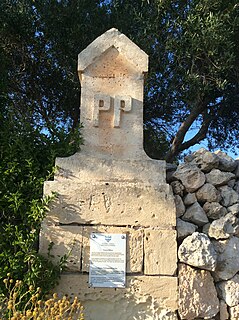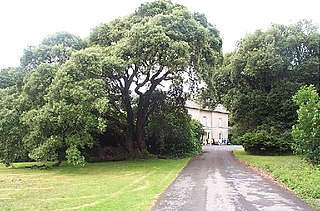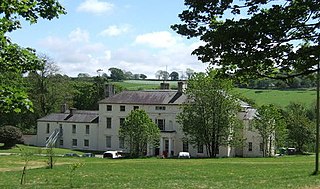
Wolfscastle also spelt Wolf's Castle, is a village and community in Pembrokeshire, between Haverfordwest and Fishguard, in southwest Wales. It was historically in the parish of St Dogwells.

Capesthorne Hall is a country house near the village of Siddington, Cheshire, England. The house and its private chapel were built in the early 18th century, replacing an earlier hall and chapel nearby. They were built to Neoclassical designs by William Smith and (probably) his son Francis. Later in the 18th century, the house was extended by the addition of an orangery and a drawing room. In the 1830s the house was remodelled by Edward Blore; the work included the addition of an extension and a frontage in Jacobean style, and joining the central block to the service wings. In about 1837 the orangery was replaced by a large conservatory designed by Joseph Paxton. In 1861 the main part of the house was virtually destroyed by fire. It was rebuilt by Anthony Salvin, who generally followed Blore's designs but made modifications to the front, rebuilt the back of the house in Jacobean style, and altered the interior. There were further alterations later in the 19th century, including remodelling of the Saloon. During the Second World War the hall was used by the Red Cross, but subsequent deterioration prompted a restoration.

Picton Castle is a medieval castle near Haverfordwest in Pembrokeshire, Wales. Originally built at the end of the 13th century by a Flemish knight, it later came into the hands of Sir John Wogan, and is till this day inhabited by his descendants, the Philipps family. It is of unusual construction and has been remodelled several times during its history. It is a Grade I listed building.

Hafodunos Hall is a Gothic revival house located near the village of Llangernyw in Wales. Designed by Sir George Gilbert Scott, it was built between 1861 and 1866 for Henry Robertson Sandbach, replacing a house that had been built in 1674. The house, of Venetian-Gothic design, is considered Scott's second-most important country house after Kelham Hall, Nottinghamshire and arguably his most important Welsh building. Subject to a devastating fire in 2004, the ruins are being restored. The Hall is a Grade I listed building, with many of the buildings and structures in the grounds having their own listings.
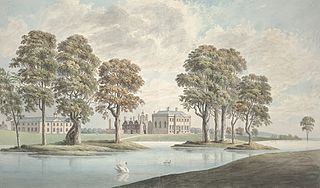
Wynnstay is a country house located in an important landscaped park 1.3 km south-east of Ruabon, near Wrexham, Wales. Wynnstay, previously Watstay, was a famous estate and the family seat of the Wynns.

Glynllifon is the name of the old estate which belonged to the Lords Newborough, near the village of Llandwrog on the main A499 road between Pwllheli and Caernarfon in Gwynedd, Wales The original mansion is now a privately owned Country House hotel and wedding venue.

Treffgarne is a small village and parish in Pembrokeshire, south-west Wales. It lies to the south of the Preseli Hills close to the Western Cleddau river, and close to the main A40 road from Fishguard to Haverfordwest. The area has an interesting local geology and evidence of mineral extraction at least as far back as Roman times. The present village is medieval in origin.

Cwm Gwaun is a community and valley in north Pembrokeshire, Wales. The community is centred around Pontfaen, a hamlet 4 miles (6.4 km) southeast of Fishguard. In 2011, the population was 313. The valley is known for its unspoilt nature and old-world pub, and there are numerous other listed buildings.

The Beaufort Arms Hotel, Agincourt Square, Monmouth, Monmouthshire, south-east Wales is a former coaching inn dating from the early eighteenth century, though the frontage may have been modified by the prolific early Victorian architect George Vaughan Maddox in the 1830s. A stone cornice on the central block still carries the inscription "The Beaufort Arms". It is a Grade II* listed building as of 27 June 1952. It is one of 24 buildings on the Monmouth Heritage Trail.

High Glanau is a country house and Grade II* listed building within the community of Cwmcarvan, Monmouthshire, Wales. It is located about 5 miles (8.0 km) south-west of Monmouth, and 1.5 miles (2.4 km) north of Trellech, adjoining the B4293 road and with views westwards over the Vale of Usk. It is particularly noted for its gardens.

Durrants Hotel is located in George Street, London.

The Salutation is a grade I listed house in Sandwich, Kent. It was designed and built by Edwin Lutyens in a Queen Anne style in 1911–12, as a weekend home and country retreat for members of the Farrer family. It was one of the first 20th-century building to be given a grade I listing, in 1950. Other structures in the grounds received a grade II listing in 1986. It has been described by Nigel Jones as "the perfect house that many in Britain aspire to own", and by Arthur Stanley George Butler as "Sir Edwin's supreme rendering of the full Georgian idiom … This very perfect work establishes itself as a high peak in Sir Edwin's achievement".
Sodston Manor is a heritage listed Victorian manor house located near Narberth, Pembrokeshire, Wales. It is currently run as a private secondary school, Castle School Pembrokeshire.
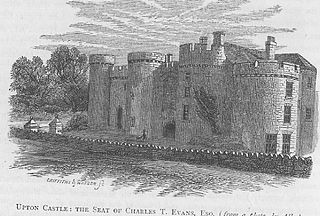
Upton Castle is a 13th-century castle or fortified manor house with an associated chapel, located near Cosheston, Pembrokeshire in Wales. Although in private ownership, the gardens are open to the public.

Ffynone is a mansion and estate near Boncath, Pembrokeshire, Wales, in the parish of Manordeifi. The original Georgian design was by architect John Nash and later remodelled by Inigo Thomas.

Nashdom, also known as Nashdom Abbey, is a former country house and former Anglican Benedictine abbey in Burnham, Buckinghamshire, England. Designed in Neo-Georgian style by architect Edwin Lutyens, it is a Grade II* listed building. It was converted into apartments in 1997. The gardens are Grade II listed in the National Register of Historic Parks and Gardens.

Orielton is a historic country house near Hundleton in Pembrokeshire, Wales. It is used as a field studies centre for environmental sciences.
